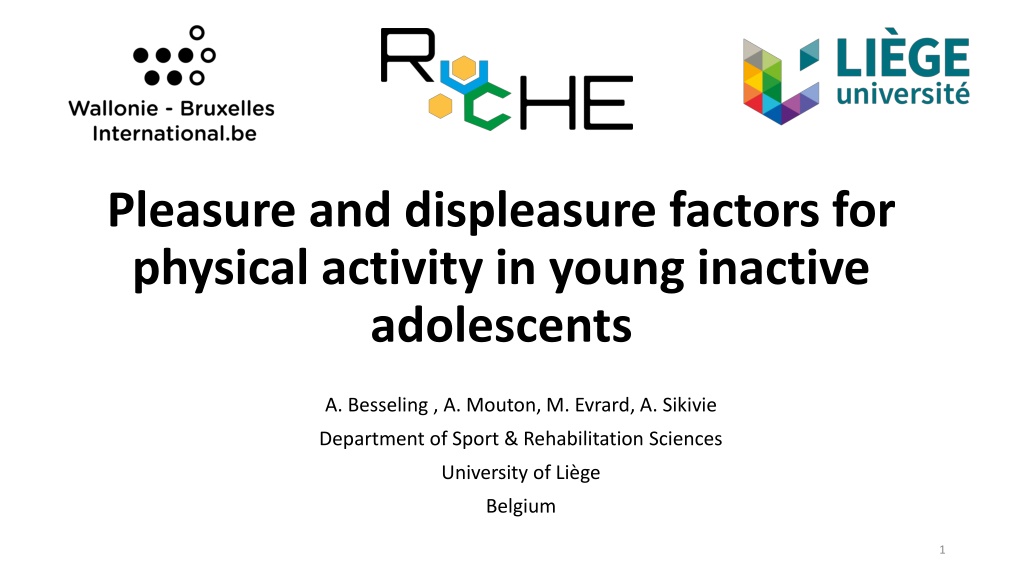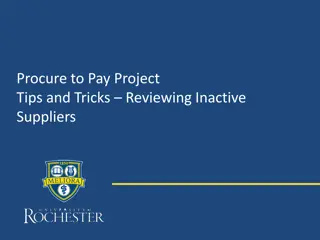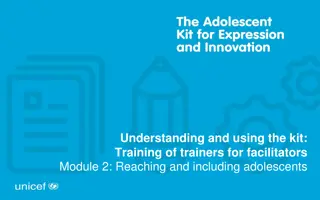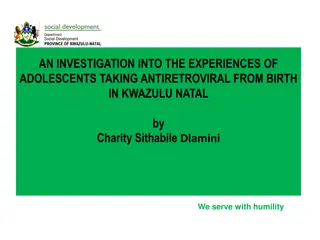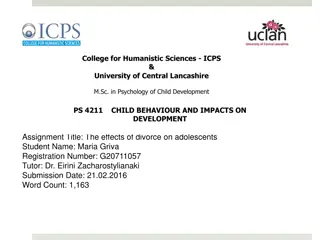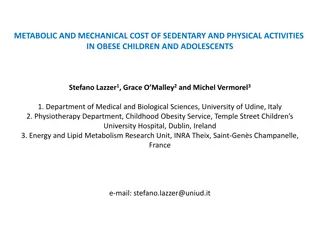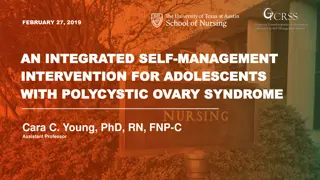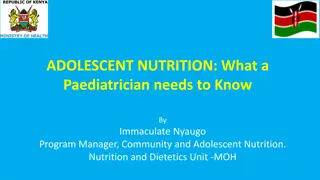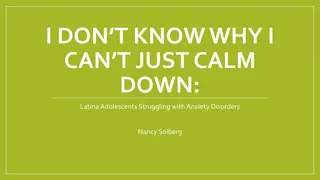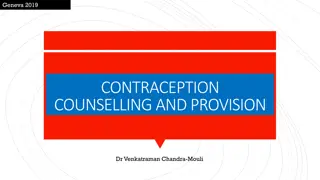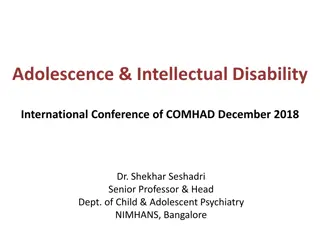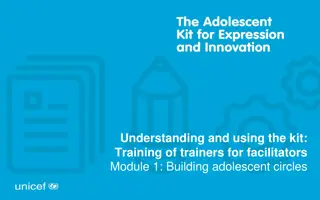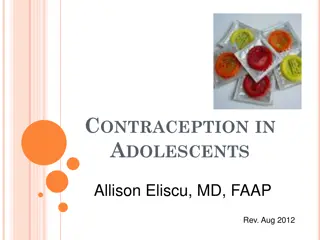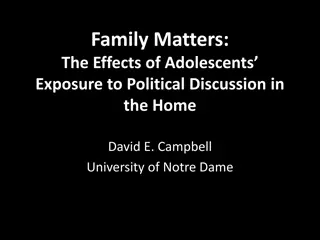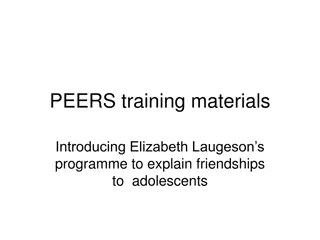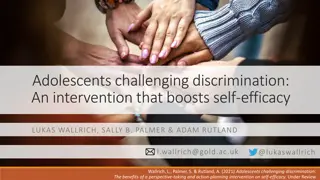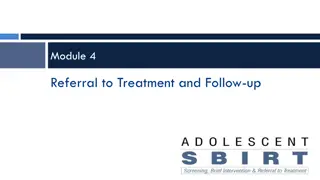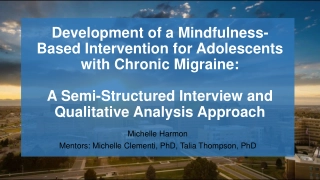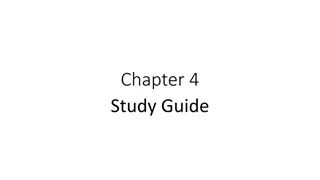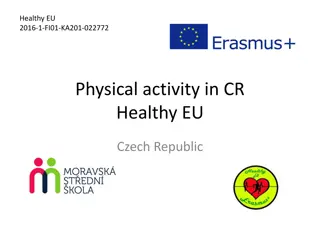Factors Influencing Pleasure and Displeasure in Inactive Adolescents' Physical Activity
Factors influencing pleasure and displeasure in physical activity among inactive adolescents play a critical role in promoting active lifestyles. Understanding these factors, such as intensity of effort and gender differences, can help tailor interventions to enhance enjoyment and participation in physical activities during adolescence.
Download Presentation

Please find below an Image/Link to download the presentation.
The content on the website is provided AS IS for your information and personal use only. It may not be sold, licensed, or shared on other websites without obtaining consent from the author. Download presentation by click this link. If you encounter any issues during the download, it is possible that the publisher has removed the file from their server.
E N D
Presentation Transcript
Pleasure and displeasure factors for physical activity in young inactive adolescents A. Besseling , A. Mouton, M. Evrard, A. Sikivie Department of Sport & Rehabilitation Sciences University of Li ge Belgium 1
Is physical activity pleasant for everyone? VS Dream Reality 2
Introduction What factors influence young inactive teenagers pleasure and displeasure of physical activity? 3
Physical activity during adolescence, a societal challenge? Adolescence is a time of change (Discour, 2011) Transition from childhood to adolescence is crucial (Kemp, Cliff, Chong & Parrish, 2018) During adolescence, the mean percentage PA decline per year is -7% (Dumith, Gigante, Domingues & Harold, 2010) PA during adolescence as a predictor of adult PA practice (Thompson, Humbert & Mirwald, 2003) Focusing on young inactive teens is effective for promoting PA (Bajamal, Hashish & Robbins, 2020) 4
Why target the notion of pleasure ? Experiences of pleasure and displeasure are linked to the practice of physical activity (Williams & Evans, 2014) Linking pleasure or displeasure affects with physical activity in our memory is a predictor of exercise behavior (Ekkekakis & Dafermos, 2012) The use of strategies designed to promote enjoyment of physical activity is effective (Bajamal, Hashish & Robbins, 2020) 5
Introduction Objectives & Methods What factors influence young inactive teenagers pleasure and displeasure of physical activity? 6
Objectives Primary objective Identify pleasure and displeasure factors in young inactive adolescents Secondary objectives Identify the optimal intensity of effort for pleasure Identify the most important factors for girls and boys 7
Method 52 inactive students Semi-structured interviews Affect and health behavior framework (Williams & Evans, 2014) First step on the continuum : Previous affective response Critical incident technique (Flanagan, 1954) Feeling scale (Hardy & Rejeski, 1989) 8
Analysis Pleasure and intensity of effort - Quantitative analysis Friedman test Wilcoxon signed-rank test - Holm s method (P) Effect size (r) Pleasure and displeasure factors for PA - Qualitative analysis Meaning units Pleasure & displeasure for PA (inactive students, inactive boys, inactive girls) 9
Introduction Objectives & Methods What factors influence young inactive teenagers pleasure and displeasure of physical activity? Results 10
Level of pleasure as a function of activity intensity P<0,001 r : 0,63 Pleasure of MPA significantly higher than pleasure of IPA (P<0,001) Important effect size (r : 0,63) Pleasure is reduced at the onset of lactate accumulation in the blood (Ekkekakis, Parfitt & Petruzzello, 2011) IPA MPA 11
Classification of sources of pleasure for physical activity (based on causal attribution theory) Inactive students' sources of pleasure for PA - Sense of autonomy - Sense of competence and self-accomplishment - Sense of proving your competence - Sense of pride - Emotional state - Positive reinforcement - Activity type - People present at the activity - Reinforcement through play - Environment - Challenges - Learning / discovery - Breaking the routine - Routine - Ambience - Weather Internal source : Feelings can influence their pleasure External source : Pleasure is controlled by environmental factors (Fullin & Mills, 1995) Internal source External source 12
Classification of sources of displeasure for physical activity (based on causal attribution theory) Internal source : Feelings can influence their pleasure External source : Pleasure is controlled by environmental factors (Fullin & Mills, 1995) Inactive students' sources of displeasure for PA - Pain and the physical repercussions of physical activity - Emotional state - Sense of competence and self-confidence - False beliefs - Previous personal experience - Health - Body appearance and physical capacity - Activity type - The gaze of others - Weather - Negative results of an activity - Ambience - Constraint - People present at the activity and their behavior - Monotony / boredom - Pressure Internal source External source 13
Factors contributing to pleasure of physical activity cited at least 10 times by inactive students 35 Number of citations (n : 52) 30 25 20 15 10 5 0 People present at the activity Reinforcement through play Sense of competence and self- accomplishment Activity type Social support is an important factor associated with physical activity level in adolescents (Mendon a, Cheng, M lo & Cazuza de Farias, 2014) 14
Factors contributing to displeasure of physical activity cited at least 10 times by inactive students 25 20 Number of citations (n : 52) 15 10 5 0 Pain and the physical repercussions of physical activity Body appearance and physical capacity The gaze of others Activity type Emotional state Negative results of an activity Negative affective associations with responses to exercise, such as pain and discomfort during vigorous exercise (Williams & Evans, 2014) 15
Factors contributing to pleasure of physical activity cited at least 4 times by inactive boys 18 16 Number of citations (n : 32) 14 12 10 8 6 4 2 0 People present at the activity Reinforcement through play Sense of competence and self- accomplishment Sense of proving your competence Ambience Activity type Boys have higher self-esteem than girls (Fourchard & Courtinat-Camps, 2013) Boys participation in PA could improve their self-esteem (Daniels & Leaper, 2006) 16
Factors contributing to pleasure of physical activity cited at least 4 times by inactive girls 16 14 Number of citations (n : 20) 12 10 8 6 4 2 0 People present at the activity Activity type Sense of pride Ambience Encouragement is an important factor in increasing PA levels among girls (Vander Ploeg, Kuhle, Maximova, McGavock, Wu & Veugelers, 2013) 17
Factors contributing to displeasure of physical activity cited at least 5 times by inactive boys 14 12 Number of citations (n : 32) 10 8 6 4 2 0 Pain and the physical repercussions of physical activity Body appearance and physical capacity Negative results of an activity Previous personal experience The gaze of others Activity type Emotional state 18
Factors contributing to displeasure of physical activity cited at least 5 times by inactive girls Girls attach importance to their appearance, but are relatively dissatisfied with it, which affects their self- esteem (Fourchard & Courtinat-Camps, 2013) The gaze of others can influence self-worth (Rochat, 2013) 9 8 7 Number of citations (n : 20) 6 5 4 3 2 1 0 The gaze of others Pain and the physical repercussions of physical activity Activity type Body appearance and physical capacity Constraint Emotional state 19
Introduction Objectives & Methods What factors influence young inactive teenagers pleasure and displeasure of physical activity? Conclusion & perspectives Results 20
Conclusion & perspectives Conclusion : Multiple factors influencing the pleasure and displeasure of physical activity Moderate physical activity (> avoid pain) Importance of the social aspect and sense of competence Perspectives : Future studies should not restrict the exploration of pleasure to inactive students Guide PE teachers to : 1) Detect students who practice PA with displeasure 2) Set up interventions to elicit pleasure for these students 21
Thank you for your attention Thank you for your attention 22
References References Bajamal, E., Abou Hashish, E. A., & Robbins, L. B. (2022). Enjoyment of Physical Activity among Children and Adolescents: A Concept Analysis. Journal of School Nursing. https://doi.org/10.1177/10598405221137718 Bok, D., Rakovac, M., & Foster, C. (2022). An Examination and Critique of Subjective Methods to Determine Exercise Intensity: The Talk Test, Feeling Scale, and Rating of Perceived Exertion. In Sports Medicine (Vol. 52, Issue 9, pp. 2085 2109). Springer Science and Business Media Deutschland GmbH. https://doi.org/10.1007/s40279-022-01690-3 Daniels, E., & Leaper, C. (2006). A longitudinal investigation of sport participation, peer acceptance, and self-esteem among adolescent girls and boys. Sex Roles, 55(11 12), 875 880. https://doi.org/10.1007/s11199-006-9138-4 Discour, V. (2011). Changements du corps et remaniement psychique l adolescence. Les Cahiers Dynamiques, 50(1), 40. https://doi.org/10.3917/lcd.050.0040 Dumith, S. C., Gigante, D. P., Domingues, M. R., & Kohl, H. W. (2011). Physical activity change during adolescence: A systematic review and a pooled analysis. International Journal of Epidemiology, 40(3), 685 698. https://doi.org/10.1093/ije/dyq272 Ekkekakis, P. & Dafermos, M. (2012). Exercise Is a Many-Splendored Thing, but for Some It Does Not Feel So Splendid: Staging a Resurgence of Hedonistic Ideas in the Quest to Understand Exercise Behavior. Oxford University Press) Inc. Ekkekakis, P., Parfitt, G., & Petruzzello, S. J. (n.d.). The Pleasure and Displeasure People Feel When they Exercise at Different Intensities Decennial Update and Progress towards a Tripartite Rationale for Exercise Intensity Prescription. Flanagan, J. C. (1954). The critical incident technique. Psychological Bulletin, 51(4), 327 358. https://doi.org/10.1037/h0061470 Fourchard, F., & Courtinat-Camps, A. (2013). L estime de soi globale et physique l adolescence. Neuropsychiatrie de l Enfance et de l Adolescence, 61(6), 333 339. https://doi.org/10.1016/j.neurenf.2013.04.005 Fullin, C., & Mills, B. D. (n.d.). Attribution Theory in Sport: Problems and Solutions. Kemp, B. J., Cliff, D. P., Chong, K. H., & Parrish, A. M. (2019). Longitudinal changes in domains of physical activity during childhood and adolescence: A systematic review. In Journal of Science and Medicine in Sport (Vol. 22, Issue 6, pp. 695 701). Elsevier Ltd. https://doi.org/10.1016/j.jsams.2018.12.012 Mendon a, G., Cheng, L. A., M lo, E. N., & de Farias J nior, J. C. (2014). Physical activity and social support in adolescents: A systematic review. In Health Education Research (Vol. 29, Issue 5, pp. 822 839). Oxford University Press. https://doi.org/10.1093/her/cyu017 Ploeg, K. A. vander, Kuhle, S., Maximova, K., Mcgavock, J., Wu, B., & Veugelers, P. J. (2013). The importance of parental beliefs and support for pedometer-measured physical activity on school days and weekend days among Canadian children. http://www.biomedcentral.com/1471-2458/13/1132 Rochat, P. (2013). The gaze of others. In M. R. Banaji & S. A. Gelman (Eds.), Navigating the social world: What infants, children, and other species can teach us (pp. 205 211). Oxford University Press.https://doi.org/10.1093/acprof:oso/9780199890712.003.0037 Thompson, A. M., Humbert, M. L., & Mirwald, R. L. (2003). A longitudinal study of the impact of childhood and adolescent physical activity experiences on adult physical activity perceptions and behaviors. Qualitative Health Research, 13(3), 358 377. https://doi.org/10.1177/1049732302250332 Williams, D. M., & Evans, D. R. (2014). Current emotion research in health behavior science. In Emotion Review (Vol. 6, Issue 3, pp. 277 287). SAGE Publications Ltd. https://doi.org/10.1177/1754073914523052 23
